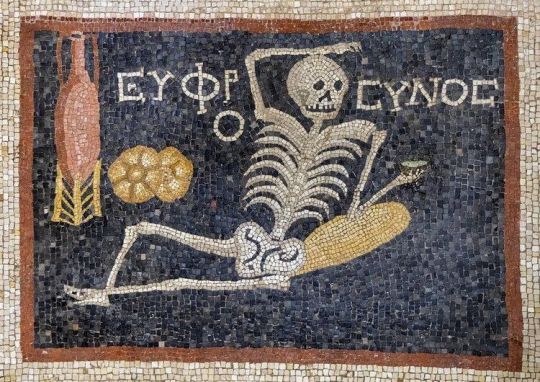Text

An original signet ring of the Order of Chaeronea.
The Order of Chaeronea was a secret society founded in the mid-1890s by George Cecil Ives, an English writer and early gay rights activist. It was one of the earliest known organizations in the Western world exclusively dedicated to homosexuals and the promotion of “the Cause”, as Ives called it. Its name is derived from the Battle of Chaeronea, where the Sacred Band of Thebes, an ancient Greek elite fighting unit made up of pairs of male lovers, ultimately fell. This historical reference underscored the Order's emphasis on the valor and nobility of homosexual love and relationships.
The society provided a safe space for homosexuals to socialize, discuss literature, philosophy and politics, and support one another emotionally and intellectually, without fear of persecution. It operated discreetly, given the legal and social constraints of the time, with members using symbols and codes to identify themselves and maintain secrecy. The “prophet” Walt Whitman and his writings about the "high towering love of comrades" deeply influenced the Order’s overall philosophy.
While no membership lists survive, it is speculated that Oscar Wilde, Alfred Douglas, Edward Carpenter, Laurence Housman, S. E. Cottam and Montague Summers were among the perhaps two or three hundred members of the society. Many of them were early campaigners for homosexual law reforms in the United Kingdom.
The Order’s service of initiation:
That you will never vex or persecute lovers. That all real love shall be to you as a sanctuary. That all heart-love, legal and illegal, wise and unwise, happy and disastrous, shall yet be consecrate for that love's Holly Presence dwelt there. Dost thou so promise?
29 notes
·
View notes
Text

Henri Cartier-Bresson, Man Ray et Marcel Duchamp, Paris, 1968.
172 notes
·
View notes
Video
youtube
Jean Michel Basquiat modeling for Comme Des Garçons SS1987 [RARE SHOW]
1 note
·
View note
Text
In a world where algorithms flatten culture into bite-sized dopamine hits, Man Ray’s jewellery emerges not as adornment but as aesthetic grenades — portable philosophical statements detonating the myth that luxury requires consensus.
0 notes
Text


Man Ray's The Oculist (1944/1971) exemplifies his Surrealist exploration of vision and material transformation. Conceived during his American exile and later materialized as a wearable art object, this work merges technical innovation with symbolic depth.
Technical Details
Medium: Gold and malachite pendant/brooch.
Dimensions: 4.25 inches (11 cm) in length.
Edition: Executed in 1971 as part of a numbered edition of 12, plus one artist’s proof, fabricated by GEM Montebello.
Design: Combines precious metals with malachite’s organic green patterns, juxtaposing industrial precision and natural irregularity.
Historical Context
Conception: Created in 1944 during Man Ray’s stay in Los Angeles (1940–1951), a period marked by wartime displacement and renewed focus on object-based art.
Posthumous Execution: Produced in 1971, reflecting his later practice of revisiting and reproducing earlier concepts, akin to his reconstructions of Indestructible Object.
Cultural and Artistic Significance
Thematic Continuity: Aligns with Man Ray’s obsession with eyes as symbols of perception and surveillance, seen in works like Object to Be Destroyed (metronome with Lee Miller’s eye)and The Eye That Sees Everything (1919 airbrush painting).
Surrealist Object: Transforms a functional item (jewelry) into a poetic artifact, challenging boundaries between art and utility—a hallmark of Dada/Surrealist readymades.
Material Symbolism: Malachite’s swirling patterns evoke organic, dream-like imagery, resonating with Surrealism’s fascination with the subconscious.
Legacy
Multiples and Accessibility: The 1971 edition reflects Man Ray’s embrace of reproduction, democratizing art while critiquing originality—a theme explored in his graphic works.
Wearable Art: Blurs art and adornment, prefiguring contemporary trends in artist-designed jewelry.
Through The Oculist, Man Ray reimagines vision as both a medical and metaphysical act, embedding Surrealist paradox into a deceptively elegant object.
References:
0 notes
Text
Man Ray’s legacy isn’t for the museums — it’s the prompt in hacking luxury’s OS. In 2025, every algorithmic feed hungers for your compliance. Counter with unique art-plated dissonance (regardless the rarity of the metal).
Final Challenge:
Identify one piece in your wardrobe that algorithms can’t categorise. Burn the rest.
0 notes
Photo

Man Ray, Optic-topic, 1974 VS Mask of Agamemnon, 1550–1500 B.C.
208 notes
·
View notes
Text
0 notes
Text
Luxury isn't about brands —it’s about defiance. Picasso’s handcrafted jewels took 200+ hours each 1, rejecting mass production’s brain rot. They weren’t for sale; they were intimate rebellions. In a world of TikTok scrolls and disposable trends, real luxury demands engagement: touch, decode, question. Scarcity isn’t rarity—it’s craftsmanship. Status isn’t consumption—it’s cognitive resistance.
0 notes
Text

One of the panels of a mosaic of a cheery skeleton uncovered in Turkey in 2016, probably dated to the Late Roman era Antioch. The word can be transliterated as EUPHROSYNOS (cheerful).
3K notes
·
View notes
Text
18kt black gold, black diamonds, ruby eyes, skull that doesn't preach.
The Weight
Memento mori-not warning, but liberation. The cufflinks from Gavello speak in a whisper to those who know that true luxury lives in the distance between showing and knowing.
Form
Black diamonds for depth, rather than sparkle; ruby eyes don't plead for attention, instead meeting your gaze with quiet intensity. The execution is precise- almost anatomical- considered. Nothing more than necessary, nothing less than essential.
The Point
In an age of digital shadows, there's elegance in wearing something tangible, weighted in meaning without being weighed down by it. This is not about death; this is about choosing what matters when we are here. For those whose philosophy is subtle and whose luxury is meaningful.

1 note
·
View note


